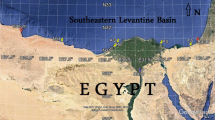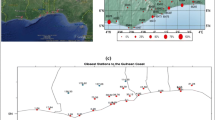Abstract
Two well-developed sea-breeze cases in the La Plata River region, selected from a 5-month summer period, are studied using local observations, satellite images, and hydrostatic boundary-layer model simulations. Both the northern and southern coast cases are characterized by offshore regional flow that help develop stronger sea breezes due to enhanced horizontal convergence by the opposing flow. The study shows that the sea-breeze propagation accompanies changes in the three-dimensional circulation within the boundary layer. The inland propagation speed of the cloud bands evident in satellite imagery is simulated relatively well by the model’s progression of maximum vertical motion in both cases. Local coastline features affect the inland penetration of the sea-breeze fronts. The inland propagation speed of the surface sea-breeze front estimated with the model simulations is greater than the speed of the cloud bands aloft.


(Reproduced with permission from Fig. 2 of Berri and Bertossa 2018)











Similar content being viewed by others
References
Alpert P, Rabinovich-Hadar M (2003) Pre-and post-sea-breeze frontal lines—a Meso-γ-scale analysis over South Israel. J Atmos Sci 60:2994–3008
Arritt RW (1993) Effects of the large-scale flow on characteristic features of the sea breeze. J Appl Meteorol 32:116–125
Atkinson BW (1981) Meso-scale atmospheric circulations. Academic Press, London
Azorin-Molina C, Chen D (2009) A climatological study of the influence of synoptic-scale flows on sea breeze evolution in the Bay of Alicante (Spain). Theor Appl Climatol 96:249–260
Banta RM, Lisa DO, Levinson DH (1993) Evolution of the Monterey Bay sea-breeze layer as observed by pulsed Doppler lidar. J Atmos Sci 50:3959–3982
Barbato JP (1978) Areal parameters of the sea breeze and its vertical structure in the Boston basin. Bull Am Meteorol Soc 59:1420–1431
Bastin S, Drobinski P (2006) Sea-breeze-induced mass transport over complex terrain in south-eastern France: a case-study. Q J R Meteorol Soc 132:405–423
Bastin S, Drobinski P, Dabas A, Delville P, Reitebuch O, Werner C (2005) Impact of the Rhône and Durance valleys on sea-breeze circulation in the Marseille area. Atmos Res 74:303–328
Berri GJ, Bertossa G (2018) Initializing a mesoscale boundary-layer model with radiosonde observations. Boundary-Layer Meteorol 166:137–151
Berri GJ, Nuñez MN (1993) Transformed shoreline following horizontal coordinates in a mesoscale model: a sea land breeze case study. J Appl Meteorol 32:918–928
Berri GJ, Sraibman L, Tanco R, Bertossa G (2010) Low-level wind field climatology over the La Plata River region obtained with a mesoscale atmospheric boundary layer model forced with local weather observations. J App Meteorol Climatol 49:1293–1305
Berri GJ, Galli Nuin J, Sraibman L, Bertossa G (2012) Verification of a synthesized method for the calculation of low-level climatological wind fields using a mesoscale boundary-layer model. Boundary-Layer Meteorol 142:329–337
Borne K, Chen D, Nunez M (1998) A method for finding sea breeze days under stable synoptic conditions and its application to the Swedish west coast. Int J Climatol 18:901–914
Chen F, Miao S, Tewari M, Bao JW, Kusaka H (2011) A numerical study of interactions between surface forcing and sea breeze circulations and their effects on stagnation in the greater Houston area. J Geophys Res 116(D12105). https://doi.org/10.1029/2010JD015533
Chen G, Iwai H, Ishii S, Saito K, Seko H, Sha W, Iwasaki T (2019) Structures of the sea-breeze front in dual-Doppler lidar observation and coupled mesoscale-to-LES modeling. J Geophys Res Atmos 124:2397–2413
Comer NT, McKendry IG (1993) Observations and numerical modeling of Lake Ontario lake breezes. Atmos-Ocean 31:481–499
Cressman GP (1959) An operational objective analysis system. Mon Weather Rev 87:367–878
Crosman ET, Horel JD (2010) Sea and lake breezes: a review of numerical studies. Boundary-Layer Meteorol 137:1–29
Defant F (1951) Compendium of meteorology. American Meteorological Society, Providence, pp 658–672
Estoque MA (1962) The sea breeze as a function of the prevailing synoptic situation. J Atmos Sci 19:244–250
Federico S, Pasqualoni L, De Leo L, Bellecci C (2010) A study of the breeze circulation during summer and fall 2008 in Calabria, Italy. Atmos Res 97:1–13
Finkele K (1998) Inland and offshore propagation speeds of a sea breeze from simulations and measurements. Boundary-Layer Meteorol 87:307–329
Finkele K, Hacker JM, Kraus H, Byron-Scott RA (1995) A complete sea-breeze circulation cell derived from aircraft observations. Boundary-Layer Meteorol 73:299–317
Freitas ED, Rozoff CM, Cotton WR, Silva Dias PL (2007) Interactions of an urban heat island and sea-breeze circulations during winter over the metropolitan area of São Paulo, Brazil. Boundary-Layer Meteorol 122:43–65
Frizolla JA, Fisher EL (1963) A series of sea breeze observations in the New York City area. J Appl Meteorol 2:722–739
Furberg M, Steyn DG, Baldi M (2002) The climatology of sea breezes on Sardinia. Q J R Meteorol Soc 22:917–932
Guerrero RA, Piola AR, Molinari GN, Osiroff AP, Jauregui SI (2010) Climatologia de temperatura y salinidad en el Rio de La Plata y su frente maritimo. Argentina-Uruguay. Mar del Plata: Instituto Nacional de Investigacion y Desarrollo Pesquero INIDEP, Argentina, 95 pp
Harris L, Kotamarthi VR (2005) The characteristics of the Chicago Lake breeze and its effects on trace particle transport: results from an episodic event simulation. J Appl Meteorol 44:1637–1654
Kanamitsu M, Ebisuzaki W, Woollen J, Yang S-K, Hnilo JJ, Fiorino M, Potter GL (2002) NCEP-DOE AMIP-II Reanalysis (R-2). Bull Am Meteorol Soc 83:1631–1644
Keen CS, Lyons QA (1978) Lake/land breeze circulations on the western shore of Lake Michigan. J Appl Meteorol 17:1843–1855
Kunhikrishnan PK, Ramachandran R, Alappattu DP, Kumar NK, Balasubrahamanyam D (2006) A case study of sea breeze circulation at Thumba Coast through observations and modelling. Remote sensing and modeling of the atmosphere, oceans, and interactions. Int Soc Opt Photonics 6404:640417
Lyons WA (1972) The climatology and prediction of the Chicago lake breeze. J Appl Meteorol 11:1259–1270
Lyons WA, Tremback CJ, Pielke RA (1995) Applications of the Regional Atmospheric Modeling System (RAMS) to provide input to photochemical grid models for the Lake Michigan Ozone Study (LMOS). J Appl Meteorol 34:1762–1786
Martin CL, Pielke RA (1983) The adequacy of the hydrostatic assumption in sea breeze modeling over flat terrain. J Atmos Sci 40:1472–1481
Miao JF, Kroon LJM, de Arellano JVG, Holtslag AAM (2003) Impacts of topography and land degradation on the sea breeze over eastern Spain. Meteorol Atmos Phys 84:157–170
Miller STK, Keim BD, Talbot RW, Mao H (2003) Sea breeze: structure, forecasting, and impacts. Rev Geophys. https://doi.org/10.1029/2003RG000124
Nicholls ME, Pielke RA, Cotton WR (1991) A two-dimensional numerical investigation of the interaction between sea breezes and deep convection over the Florida peninsula. Mon Weather Rev 119:298–323
Orlanski I (1981) The quasi-hydrostatic approximation. J Atmos Sci 38:572–582
Papanastasiou DK, Melas D, Lissaridis I (2010) Study of wind field under sea breeze conditions; an application of WRF model. Atmos Res 98:102–117
Phan TT, Manomaiphiboon K (2012) Observed and simulated sea breeze characteristics over Rayong coastal area, Thailand. Meteorol Atmos Phys 116:95–111
Pielke R (2002) Mesoscale meteorological modelling. Academic Press, London, 676 pp
Planchon O, Damato F, Dubreuil V, Gouéry P (2006) A method of identifying and locating sea-breeze fronts in north-eastern Brazil by remote sensing. Meteorol Appl 13:225–234
Prtenjak MT, Grisogono B (2007) Sea-land breeze climatological characteristics along the northern Croatian Adriatic coast. Theor Appl Climatol 90:201–215
Ratto G, Berri GJ, Maronna R (2014) On the application of hierarchical cluster analysis for synthesizing low-level wind fields obtained with a mesoscale boundary layer model. Meteorol Appl 21:708–716
Shafran PC, Seaman NL, Gayno GA (2000) Evaluation of numerical predictions of boundary layer structure during the Lake Michigan Ozone Study. J Appl Meteorol 39:412–426
Simpson JE (1994) Sea breeze and local winds. Cambridge University Press, Cambridge, 234 pp
Sraibman L, Berri GJ (2009) Low level wind forecast over La Plata River region with a mesoscale boundary layer model forced by regional operational forecasts. Boundary-Layer Meteorol 130:407–422
Srinivas CV, Venkatesan R, Somayaji KM, Singh AB (2006) A numerical study of sea breeze circulation observed at a tropical site Kalpakkam on the east coast of India, under different synoptic flow situations. J Earth Syst Sci 115:557–574
Wakimoto RM, Atkins NT (1994) Observations of the sea-breeze front during CAPE. Part I: single-Doppler, satellite, and cloud photogrammetry analysis. Mon Weather Rev 122:1092–1114
Wilks DS (2011) Statistical methods in the atmospheric sciences. Academic Press, London, 704 pp
Xun-lai C, Ye-rong F, Jiang-nan L, Wen-shi L, Shao-jia F, An-yu W, Hui L (2009) Numerical simulations on the effect of sea–land breezes on atmospheric haze over the Pearl River Delta Region. Environ Model Assess 14:351–363
Zhong S, Takle ES (1992) An observational study of sea-and land-breeze circulation in an area of complex coastal heating. J Appl Meteorol 31:1426–1438
Acknowledgements
This research was partially supported by research grant PICT2012–1667 from Agencia Nacional de Promoción Científica y Tecnológica of Argentina. The authors acknowledge Servicio Meteorológico Nacional of Argentina for providing the meteorological observations, GOES-13 images and operational forecast outputs; and Comisión Administradora del Rio de La Plata for providing the buoys data. The authors are grateful to Marilia de Abreu Gregorio for assisting with data processing. The authors also acknowledge the fruitful comments and suggestions made by the anonymous reviewers that contributed to improving the quality of the paper. MD acknowledges Consejo Nacional de Investigaciones Científicas y Técnicas of Argentina for granting a postdoctoral fellowship.
Author information
Authors and Affiliations
Corresponding author
Rights and permissions
About this article
Cite this article
Berri, G.J., Dezzutti, M. A Sea-Breeze Case Study in the La Plata River Region Using Local Observations, Satellite Images, and Model Simulations. Boundary-Layer Meteorol 177, 123–147 (2020). https://doi.org/10.1007/s10546-020-00548-3
Received:
Accepted:
Published:
Issue Date:
DOI: https://doi.org/10.1007/s10546-020-00548-3




